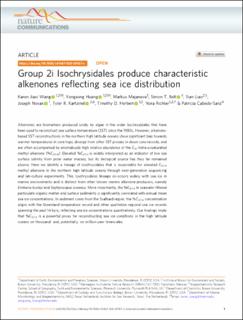| dc.contributor.author | Wang, Karen Jiaxi | |
| dc.contributor.author | Huang, Yongsong | |
| dc.contributor.author | Majaneva, Markus | |
| dc.contributor.author | Belt, Simon T. | |
| dc.contributor.author | Liao, Sian | |
| dc.contributor.author | Novak, Joseph | |
| dc.contributor.author | Kartzinel, Tyler R | |
| dc.contributor.author | Herbert, Timothy D | |
| dc.contributor.author | Richter, Nora | |
| dc.contributor.author | Cabedo-Sanz, Patricia | |
| dc.date.accessioned | 2023-03-02T14:19:06Z | |
| dc.date.available | 2023-03-02T14:19:06Z | |
| dc.date.created | 2021-02-03T10:51:47Z | |
| dc.date.issued | 2021 | |
| dc.identifier.issn | 2041-1723 | |
| dc.identifier.uri | https://hdl.handle.net/11250/3055472 | |
| dc.description.abstract | Alkenones are biomarkers produced solely by algae in the order Isochrysidales that have
been used to reconstruct sea surface temperature (SST) since the 1980s. However, alkenone based SST reconstructions in the northern high latitude oceans show significant bias towards
warmer temperatures in core-tops, diverge from other SST proxies in down core records, and
are often accompanied by anomalously high relative abundance of the C37 tetra-unsaturated
methyl alkenone (%C37:4). Elevated %C37:4 is widely interpreted as an indicator of low sea
surface salinity from polar water masses, but its biological source has thus far remained
elusive. Here we identify a lineage of Isochrysidales that is responsible for elevated C37:4
methyl alkenone in the northern high latitude oceans through next-generation sequencing
and lab-culture experiments. This Isochrysidales lineage co-occurs widely with sea ice in
marine environments and is distinct from other known marine alkenone-producers, namely
Emiliania huxleyi and Gephyrocapsa oceanica. More importantly, the %C37:4 in seawater filtered
particulate organic matter and surface sediments is significantly correlated with annual mean
sea ice concentrations. In sediment cores from the Svalbard region, the %C37:4 concentration
aligns with the Greenland temperature record and other qualitative regional sea ice records
spanning the past 14 kyrs, reflecting sea ice concentrations quantitatively. Our findings imply
that %C37:4 is a powerful proxy for reconstructing sea ice conditions in the high latitude
oceans on thousand- and, potentially, on million-year timescales. | en_US |
| dc.language.iso | eng | en_US |
| dc.rights | Navngivelse 4.0 Internasjonal | * |
| dc.rights.uri | http://creativecommons.org/licenses/by/4.0/deed.no | * |
| dc.title | Group 2i Isochrysidales produce characteristic alkenones reflecting sea ice distribution | en_US |
| dc.type | Peer reviewed | en_US |
| dc.type | Journal article | en_US |
| dc.description.version | publishedVersion | en_US |
| dc.rights.holder | © 2021 The Authors | en_US |
| dc.subject.nsi | VDP::Matematikk og Naturvitenskap: 400::Basale biofag: 470 | en_US |
| dc.source.volume | 12 | en_US |
| dc.source.journal | Nature Communications | en_US |
| dc.identifier.doi | https://doi.org/10.1038/s41467-020-20187-z | |
| dc.identifier.cristin | 1886240 | |
| dc.source.articlenumber | 15 | en_US |
| cristin.ispublished | true | |
| cristin.fulltext | original | |
| cristin.qualitycode | 2 | |

